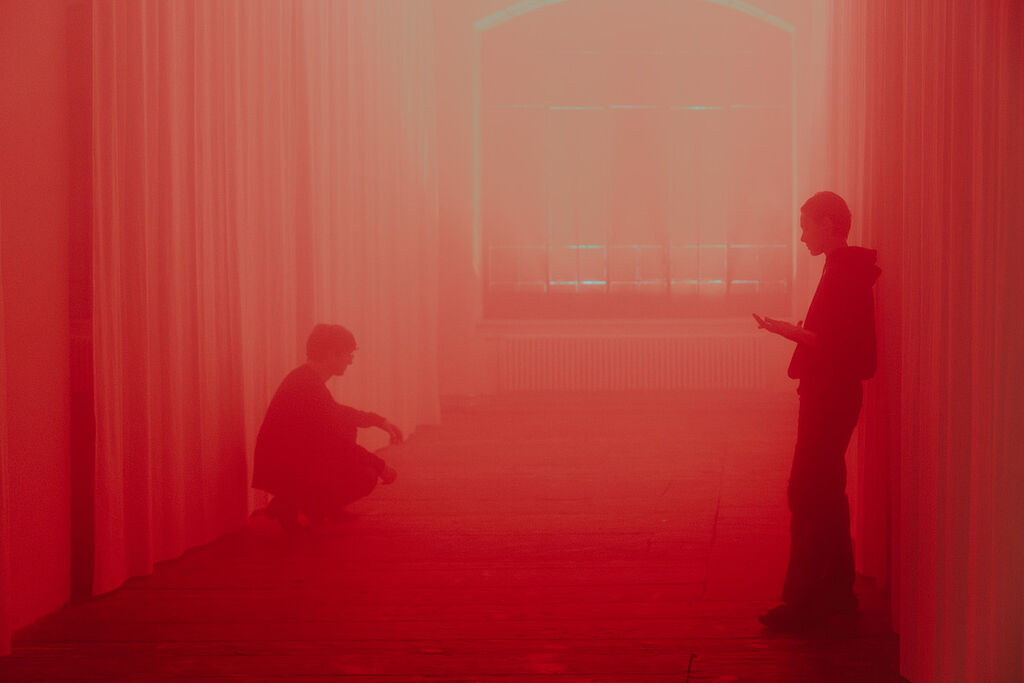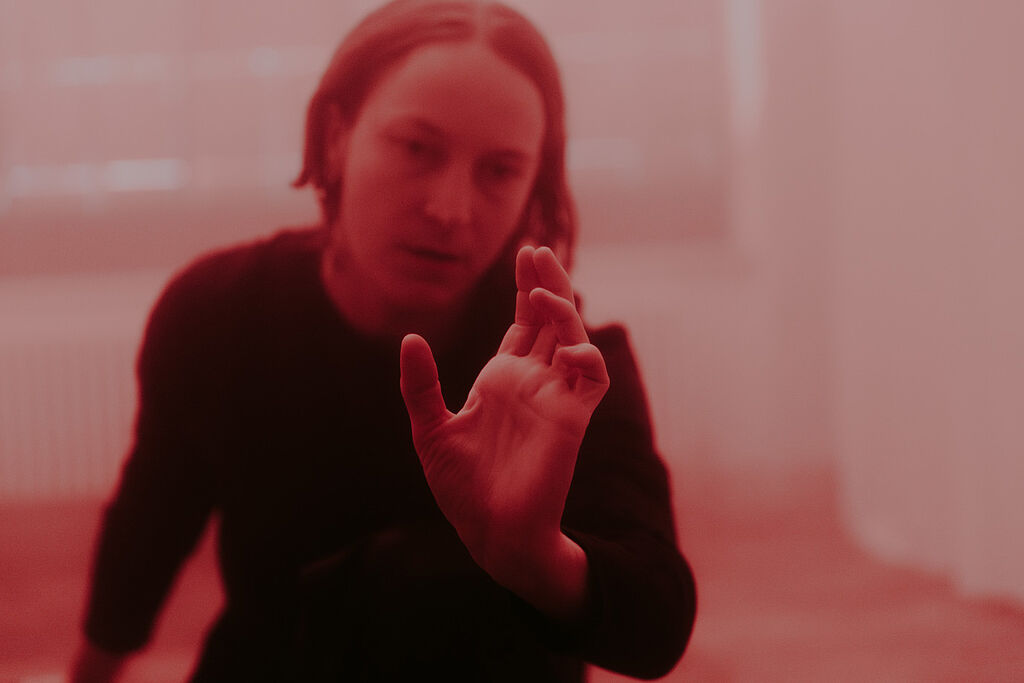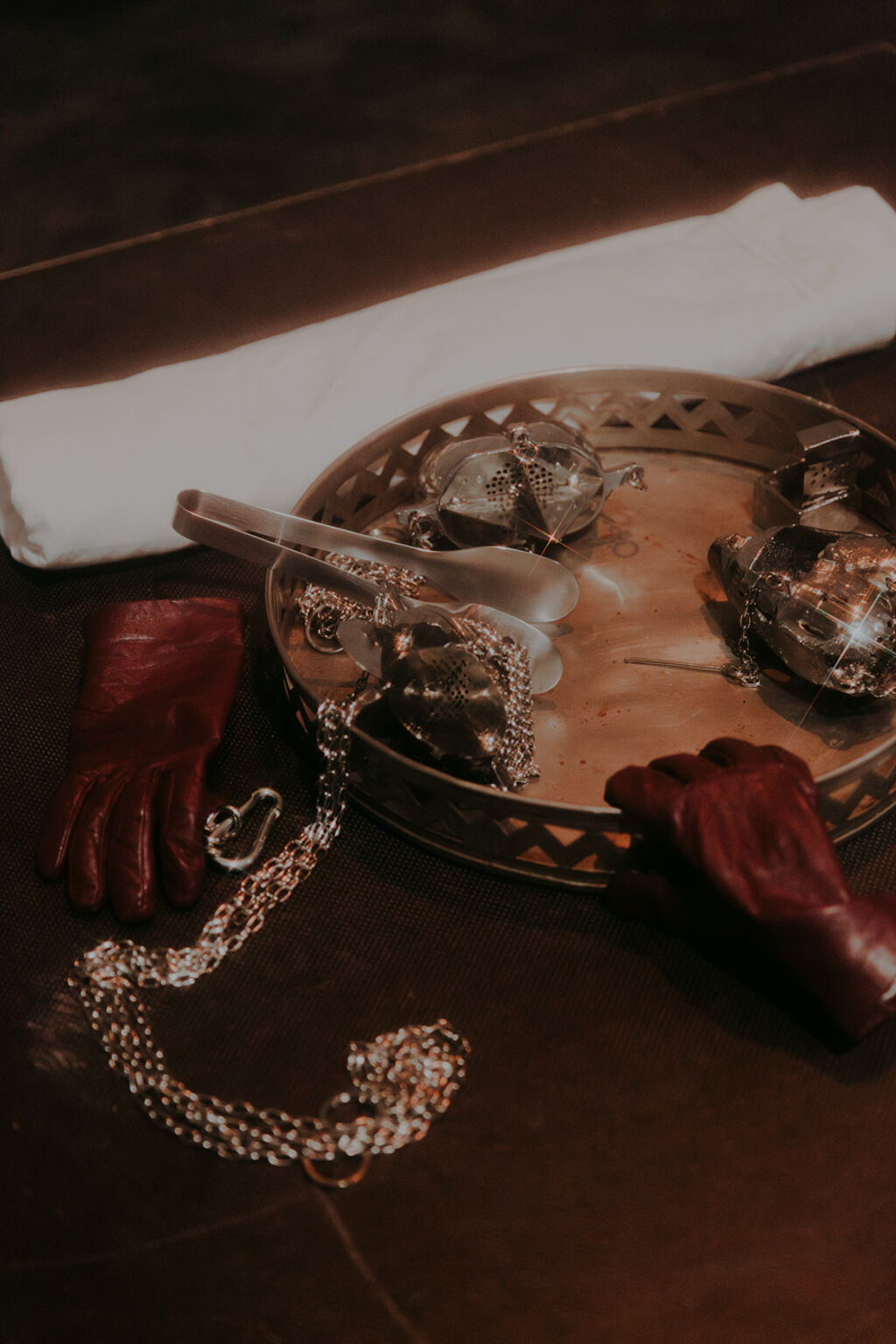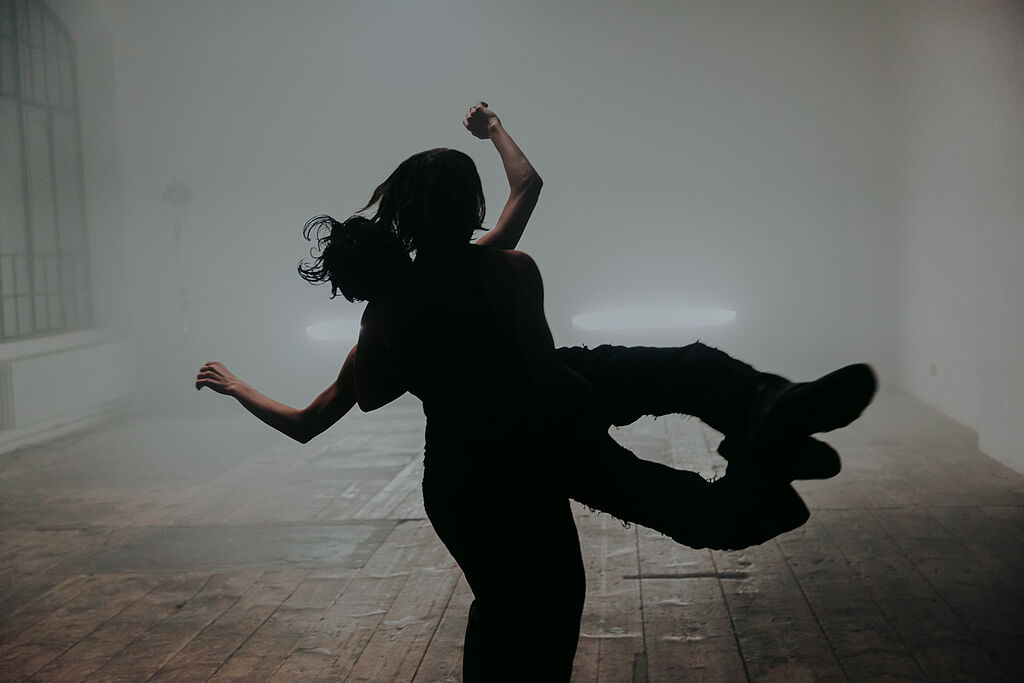
In der Performance kommen Nebel und Weihrauch zum Einsatz.
Die Performance dauert in ca 50 Minuten.
A fog machine and incense will be used during this performance.
The length of the performance is approximately 50 minutes.
Interview
Exploring the Sacred through Movement
In Latente, Martina De Dominicis explores the relationship between touch, presence, and sight, using these sensory elements to shape the choreography. Influenced by medieval history and personal memories, the piece reflects on the sacredness of touch in a visually driven world. We spoke to De Dominicis about her inspirations, the role of medieval thought, and how touch became a form of worship within the performance.
What inspired you to investigate the relations between presence, touch and sight and how do these ideas find their way into the movement vocabulary and performance choices in "Latente"?
It started during my master’s study, which unfolded through the time of the latest pandemic and social distancing. During this period I gave the time to myself to stop and observe why I do things the way I do them.
By observing how I gaze at the world around me and noticing all the different facets that the somatic experience of seeing entails, I started to write scores that encourage a way of seeing that is tactile. This means thinking of and sensing the eye as an organ of touch. At the same time I was trying to navigate the relation between dance forms and their somatic experience and how the image/representation that we have in mind of such forms, contributes to a specific sense of self in the specific moment we embody the form.
So from experimenting with gaze I started to gaze at things and images too as if I could touch them and allow this tactile information to get into my body. This practice generates a sense of presence that feels like a constant longing for images that touch my tactile body even if I am seeing them with my eyes.
In your work, the Medieval period acts as a lens through which you examine the present. What fascinates you about this era, and in what ways does it influence the choreography in "Latente"?
Part of my research delved into the cultural history of touch and and also more in general into beliefs about the inner body and body concepts in pre-modern medicine time.
In the book The deepest sense, A Cultural history of touch, Constance Classen extensively dives into the medieval time and looks at how the sense of touch was part of medieval culture. Feudal life implied proximity, art which at the time was mainly religious was meant to be touched, a handshake or a kiss had symbolic importance and was considered a sealed deal, something to trust and so on.
Medieval time also saw the transition from spoken prayers to chanted prayers as the firm believe that armonizing words would bring one closer to the divine became concrete.
During the process I listened to many medieval music compositions, sacred and profane.
We then practiced as choir with the memory of such music, looking for harmonies and singing with each other in order to touch eachother and the space. The choir is there to evoke a sense of devotion and a wish to extract, maybe reappropriate, what of the imposed religious liturgy, can still help us finding collective power and resist.
Besides keeping a strong relation to medieval music, Latente relates to the middle ages also for how it has been defined from Enlightment thinkers (whose culture completely discredited touch as a barbaric sense): the Dark Ages.
This darkness, or perhaps opacity of the present time, might require a shift within the hierarchy of the senses and question the hegemony of the visual sense and the idea of transparency.
The medieval time initially penetrated my project through a linguistic association that departs from perceiving the present time as an in-between.
Mark Fisher drew parallels between the cultural and social dynamics of the late capitalist present. He suggests that, even though we live in this hyper-technological world of apparent constant progress, there’s this strange feeling that we’ve hit a wall when it comes to imagining the future. We’re kind of stuck in a loop, where capitalism feels so inevitable that we can’t even picture anything beyond it. It’s like we’re experiencing our own kind of cultural stasis, just like people in the Middle Ages were stuck with the idea that feudalism and the church were permanent, unchangeable realities.
Yet at one point the change was there. But it appears to me, within the knowledge I have, that Renaissance, while breaking from the close past, was fueled by a Nostalgia for classical antiquity and by the wish to revive that glorious time that Renaissance people did not even experience. So they could not even miss it.
The past haunting us, our contemporary Nostalgia pandemic, especially when the world changes too fast and undergoes deep doom crises, is perhaps the most politically instrumentalized feeling today.
Touch in "Latente" takes on a sacred quality, almost like a form of worship or meditation. How did you approach embodying this sense of devotion during your creative process?
The piece unfolds in a fictionalized space of cult, in which what we worship is tactility itself. Touch, the sense on which all senses rely, is here not only what the skin experiences. It entails the capability to be emotionally touched but it extends also to that inner body feeling through which you are able to grasp yourself and say that you exist.
Referring to catholic religion as one of the ghosts of my life, we tried throughout the piece to extract the potency of sacral representation to worship something different than a god. What we worship is maybe something we see in danger or under threat. Something we want to protect and keep track of while everything else changes. What this thing to protect and to cherish is, is different to all of us. And in an exercise of speculation on a future made of disembodiment, the piece becomes a liturgy in which each part worships touch in a different ways and through different means.
"Latente" brings up the coexistence of physical bodies and ghostly presences. How do you explore this balance between the tangible and the intangible in your choreography?
Learned body behaviour, dance technique and basically all we do with our bodies, is a surrogate of things we saw from others and embodied our own way. In the case of dance techniques and the way they colonize the body , it is not uncommon how dancers try to unlearn and free themselves from dance patterns. During the process we tapped into our dance and embodied archives pulled out what, even if hidden or latent, remains active into our body memory. Without realizing we carry an infinite amount of bodies within ourselves. So we worked on letting them out in the room and literally watched them dancing, singing, performing. Those dancers we imagine to be surrounded by and that at times incarnate into our bodies, are versions of ourselves, people we saw or people we only have historical knowledge about.
The way this manifests in the choreography varies in the different parts of the performance and the ghosts accompanying us and the audience are not only bodies but also images, icones, smells, sounds and concepts. We mainly worked with ghosts by which we feel haunted.
Über das Stück
Latente explores touch as a form of manifesting what goes unseen but yet may affect by revisiting the Medieval and invoking its devotional powers. The three performers delve into the personal and collective memory of touch perception and images of touch. They spin a poetic thread across personal biographies, personal dance archives and medieval corporealities and cosmologies reverberating from their skins.
The Medieval Time, an apparent "in-between" time that seems static and suspended, is used as a lens to look at the present. Letting time move in multiple directions, allowing the imaginary and the evident coexist in all what the opaque has to offer. While the past persists in our corporeal imagination, we are haunted by the nostalgia for a future that disappears as we approach it. Maybe the devotion to tactile knowledge and to what the latent teaches us to attend could become a way of navigating the present and its problem. Practicing a state that resembles the mystic and the loving, becomes a means of navigating this spacetime.
In Latente touch becomes a sense to be worshipped and to produce worship. It becomes a performative meditation and a central question to this intimate latent dance that wants to reclaim the capability to grasp (with) our bodies as if it was something about to be lost. The eyes, the skin, the voice, the dance become a tactile organ that gives access to an array of yearning bodies and ghostly presences manifesting in the encounter between the performers and the audience.
Premiere: 17.10.2024
Additional dates: 18. & 19.10.2024
Credits
Concept, Choreography
Martina De Dominicis
Creation, Performance
Martina De Dominicis, Magdalena Forster, Manuel Riegler
Composition, Sound Design
Manuel Riegler
Costumes
Sarah Sternat
Space Design,Objects
Sarah Sternat, Patrick Winkler
Voice practice support
Veza Fernandez
Conversation partners and Dramaturgical support
Costas Kekis, Veza Fernandez
Production
Sebbe Starlinger, Sophie Menzinger
Fotos
Hanna Fasching
Coproduction of Theater im Ballsaal, Bonn and WUK performing arts.
A VORBRENNER project - funded by Stadt Innsbruck and Land Tirol.
With the kind support of the City of Vienna Culture Department, and the Federal Ministry of Arts, Culture, Civil Service and Sports Austria.
Special thanks to Elio Gervasi / Raum 33.
Biografies
Martina De Dominicis (she/her)
Martina is a Vienna based dance performer and choreographer. Starting out as a neoclassical dancer in several European institutions, she then collaborated with Cocoondance Company(DE/CH), co-creating dance pieces that have been touring through Europe, Africa, Asia and South America. In Vienna she worked with Veza Maria Fernandez, Georg Blaschke, Daphna Horenzcik, Alexander Gottfarb, Karin Pauer and Michikazu Matsune. In 2022 she received a Master degree in Movement Research at the Anton Bruckner University in Linz. Her current research and interest investigates in-between states of presence by exploring touch-sight based practices and explore the affective and tactile aspects of images. In 2019 she co-initiated with Alberto Cissello the artistic duo collective Debocs. With the piece “yet to be born” (2019) they have been invited to perform in Germany, Austria, Italy and Croatia and to choreograph a version for students at ZZT (Contemporary Dance University) in Köln. Martina’s current work is supported by the performing arts cultural department of the city of Vienna and by the Ministry of Culture of Austria.
Magdalena Forster (she/her)
Magdalena Forster (AT) is a choreographer, performer and health care professional. She likes to flirt with the potentials of curiosity, recoding a sense of anchoring or belonging, turning to personal documentation and kinetic archives. Her works are often dialogue with sculpture and sound. In addition to self initiated projects, she collaborates and performs for other artists. Her work has been supported by the BMKÖS Starting Grant for Performing Arts, project grants from the City of Vienna, Tyrol, and Innsbruck, Federal Ministry Republic Austria Section Arts and Culture as well as multiple residencies. Coproduced by Tanzquartier Wien, and presented by TQW Wien, Kunstraum Niederösterreich, Kunsthaus Zürich, Angewandte interdisciplinary Lab, Sonic Territories Festival a.o.
Costas Kekis (he/him)
Costas Kekis already danced to pop music in his living room as a child. Later, he continued this practice on stage under new circumstances: as a performer and choreographer. His works have been presented at the Ostertanztage Salzburg, and festivals in Athens and Berlin, as well as in Vienna at brut, Raw Matters, TQW, WUK, and ImPulsTanz. In addition to his work as a dancer and choreographer, he is also active as a dramaturg and choreographic consultant (Magdalena Chowaniec's 'Sanctuary', Claire Lefèvre and Evandro Pedroni's 'S/M Stage Made', Andrea Gunnlaugsdóttir and Laia Fabre's 'And all in between', Fanni Futterknecht's 'We will not let you go', Lau Lukkarila's 'Nyxxx', Liv Schellander's 'Hypernurtures', Asher O'Gorman's 'stroke all the colours out of the sky – a portrayal of the artist’s process', Daphna Horenczyk's 'PASSAGE – rehearsal for birthing and dying'). He has performed in works by Doris Uhlich, Sara Lanner, Oleg Soulimenko, and Fanni Futterknecht, among others. Recently, he artistically coordinated the Life Long Burning Program 'Performance Situation Room' at ImPulsTanz 2021 and 2022. He is a mentor/facilitator at the Tender Steps Residency for young artists by Raw Matters.
Veza María Fernández Ramos (she/her)
Veza Fernandez is a dance, voice and performance artist based in Vienna. Her work deals with the realms of the poetics and politics of vocal expression as a place of relation, imagination and transformation. She entangles singing, writing, dancing and speaking practices as bodily forms of study, experimentation and performance. Her pieces are sensitive and intense, casting polyphonically a convocation of voices and presences that yearn to move and to be moved. Her background stretches between Philology, Pedagogy, Theater, Music and Contemporary Dance. Fields that in a way or the other influence her artistic researches and modus operandi within art making and art presenting. Her work is strongly rooted locally, infiltrating from within the underground scene bigger Dance and Theater institutions. She holds a Masters in Choreography from the DAS Graduate school (Amsterdam Academy for Theatre and Dance). Her work has been shown amongst other in brut Wien, Tanzquartier Vienna, Sophiensaele Berlin, Gesnerallee Zürich, de Singel Antwerp, La Casa Encendida Madrid. www.vezafernandez.com
Manuel Riegler (he/him)
Manuel Riegler studied drums and instrumental pedagogy at the Vienna Music Institute. He works as a sound designer and composer for dance, performance, theater, film, and game art. In recent years, he has collaborated with, among others, Lau Lukarilla, Marta Navaridas, Alex Deutinger, Tiran Willemse, Rebecca Merlic, CocoonDance Company, Hungry Sharks Company, Eva-Maria Schaller and Theater Nuu. He composed the music for the film Veni Vidi Vici by Daniel Hoesl and Julia Niemann. The film premiered at the Sundance Film Festival 2024. In collaboration with Anna Russman and Kilian Immervoll, he created the short film Tinnitus Castle, which was part of the program at the Crossing Europe Festival in Linz. He played drums and percussion in different Bands and Theaterprojects, like Francis International Airport, Wealth and Shrack.
Sebbe Starlinger (he/him)
Sebastian Starlinger aka Sebbe is a Vienna based editor, social media manager and production manager. He completed his bachelor’s degree in journalism and communication studies in 2018. Sebbe’s biggest projects so far as a contributor are the webtalk FIVE SOULS ordered by German public broadcaster SWR, as well as smaller projects in queer entertainment for Netflix (i. e. Queer-Eye-Talk and The Wheel Deal). His latest projects include social media management for last years’ ImPulsTanz Performers Lau Lukkarila and Luca Bonamore and leading a crowdfunding campaign for the movie AUSTROSCHWARZ by Mwita Mataro and Helmut Karner, raising close to 21.000 Euros for the post production phase of the movie. Inspired by his Master’s in Gender Studies, Sebbe’s focus lies on queer, feminist and progressive projects and environments where his sensitivity and emotionality are applied.
Sarah Sternat (she/her)
Sarah Sternat, born in 1988 in Graz and currently living in Vienna, is a visual artist, costume, and stage designer. In 2022/2023, she completed an intensive contemporary dance program with Andrea Nagl. In 2015, she graduated with a degree in painting, tapestry, and animated film under Christian L. Attersee and Judith Eisler at the University of Applied Arts in Vienna. In 2014, Sternat co-founded the performance collective CLUB FORTUNA along with Xenia Lesniewski, Julia Rublow, Kurdwin Ayub, and Nana Mandl. Through ongoing interdisciplinary investigations that connect the human body and craftsmanship, Sarah Sternat explores how we interact with the surrounding sphere of matter. In her artistic practice, she intensely engages with the materiality of things, using a variety of media and formats to explore the relationships between the human and the non-human.
Patrick Winkler (he/him)
Born in 1992 in Graz, Patrick Winkler lives and works in Vienna. From 2014 to 2015, he attended the Friedl Kubelka School for Artistic Photography in Vienna. Between 2016 and 2023, he studied at the Academy of Fine Arts Vienna in the Department of Art and Intervention | Environment (formerly Art with Extended Pictorial Space-Action / Sculpture / Installation in Public Space) under Judith Huemer. Since 2017, he has been part of the curatorial team at the Fotogalerie Wien. In his artistic work, Patrick Winkler explores the socio-cultural characteristics of spaces, considering aspects such as publicness, privacy, and institutionality. He develops diverse media, sometimes spanning multiple spaces, to create installations. The representative aspect of sculpture at the intersection with photography is a focal point of his artistic practice. His role as a cultural worker and the associated craftsmanship for numerous artists and exhibition spaces often serve as a central starting point for new form-finding processes.





